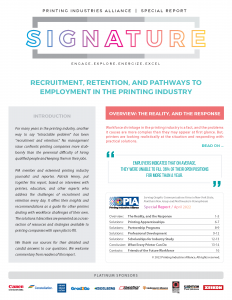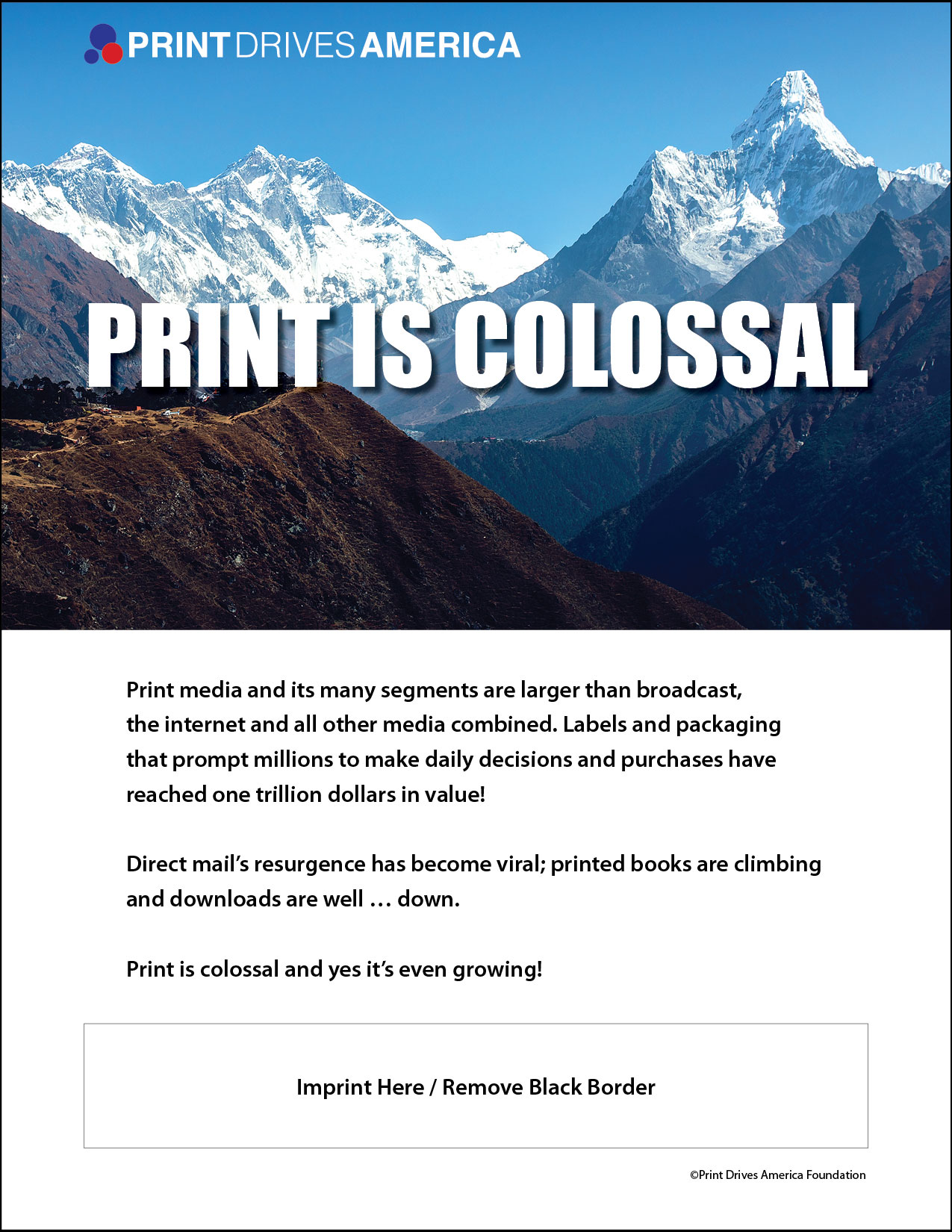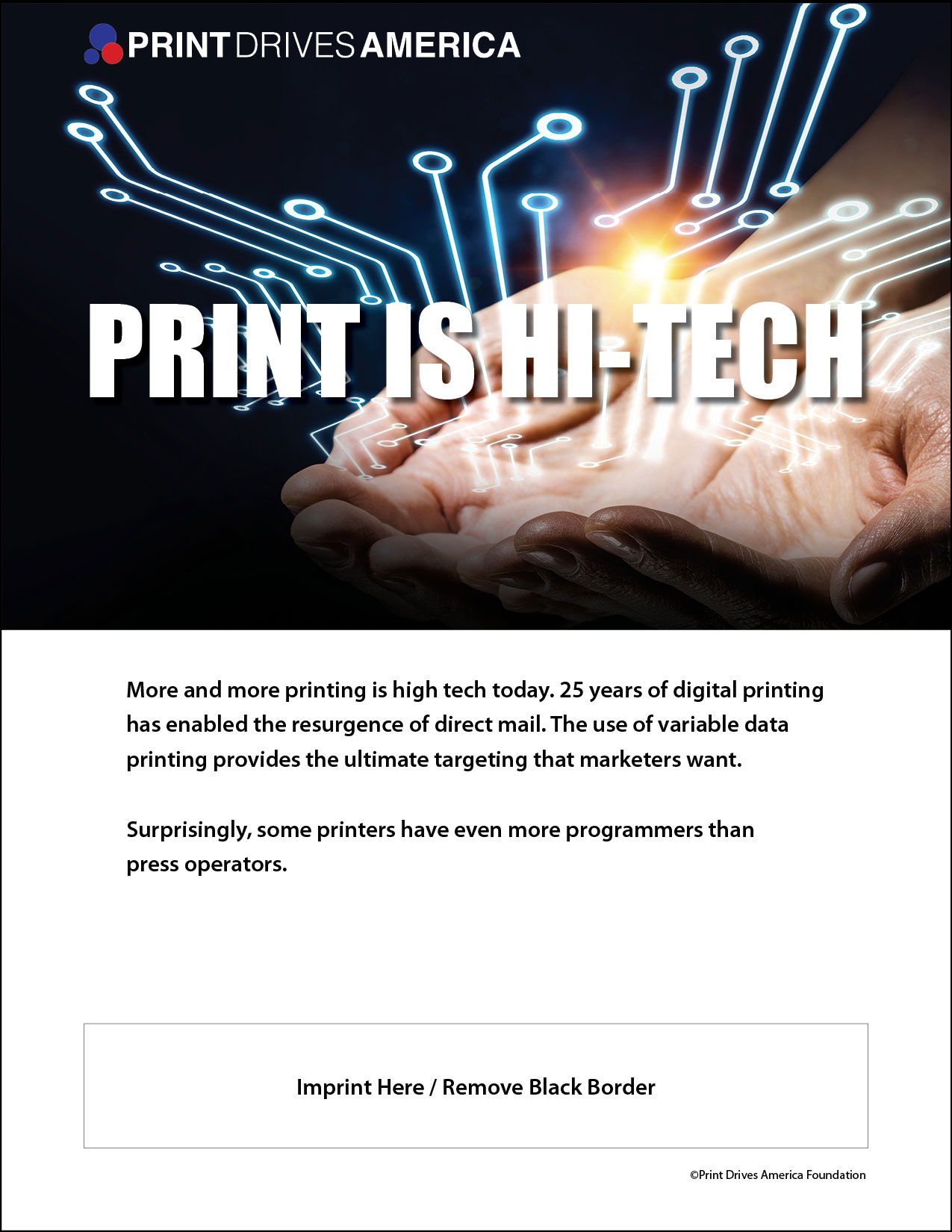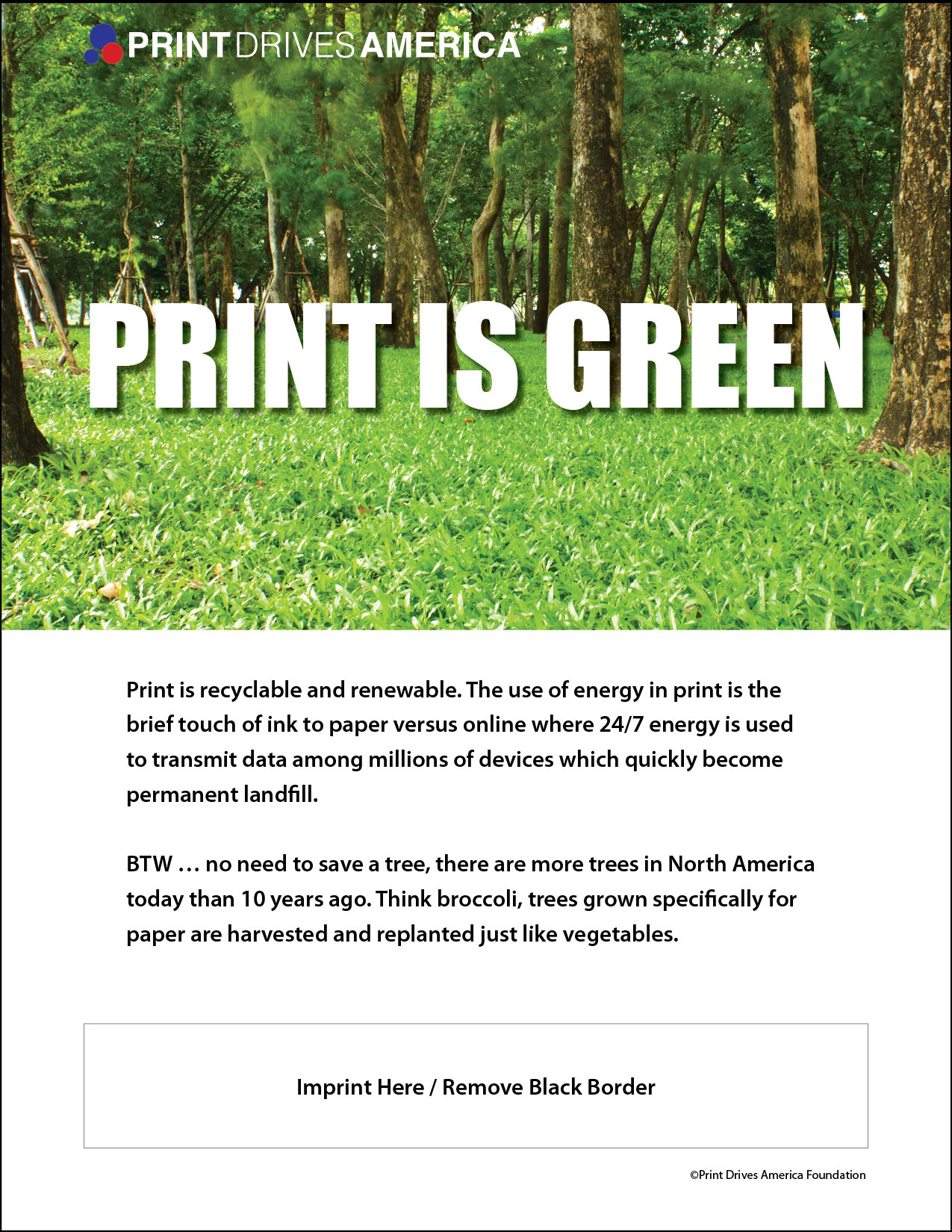By Patrick Henry, Liberty or Death Communications
Overview: The Reality, and the Response – Part 1 of the White Paper: Recruitment, Retention, and Pathways to Employment in the Printing Industry
Introduction
For many years in the printing industry, another way to say “intractable problem” has been “recruitment and retention.” No management issue confronts printing companies more stubbornly than the perennial difficulty of hiring qualified people and keeping them in their jobs.
PIA member and esteemed printing industry journalist and reporter, Patrick Henry, put together this report, based on interviews with printers, educators, and other experts who address the challenges of recruitment and retention every day. It offers their insights and recommendations as a guide for other printers dealing with workforce challenges of their own. The solutions it describes are presented as a cross-section of resources and strategies available to printing companies with open jobs to fill.
We thank our sources for their detailed and candid answers to our questions. We welcome commentary from readers of this report.
Recruitment, Retention, and Pathways to Employment in the Printing Industry
Overview: the Reality, and the Response
Workforce shrinkage in the printing industry is a fact, and the problems it causes are more complex than they may appear at first glance. But, printers are looking realistically at the situation and responding with practical solutions.
An ‘Unheard of’ Shortage of Talent
To get a clearer picture of the labor pressures that printers are facing, a coalition of 15 regional printing trade associations took part in a survey that had two aims: gauging the impact of unfilled jobs on the industry; and identifying ways in which companies can address the problems that gaps in employment cause them.
The October 2021 report, “Workforce Shortages: Its Effects and Effective Related Practices,” is one of a series of Printing Industry Performance & Insights (PIPI) reports sponsored by the coalition. It was prepared by Dr. Ralph Williams Jr. and Dr. Tim Moake of Middle Tennessee State University (MTSU), where both are professors of management in the Jones College of Business.
The findings were plain. Nearly 70% of survey respondents said that labor shortages had affected their businesses. At their companies, job turnover from all causes averaged 14%. More tellingly, employers indicated that on average, they were unable to fill 36% of their open positions for more than a year.
Williams served as the president of three printing companies before he entered academia. He says that during his career in the private sector, “we never had that kind of problem” with employment. Times clearly have changed since then. He says, for example, that a friend of his who operates a 15-employee company has experienced 50% turnover recently. “That’s unheard of for them,” Williams comments.
Experience Necessary
But not for other printers who are feeling the same pinch in their own ways. Thomas J. Majerski, president of BNP Empowered Printing in Buffalo, NY, oversees a heatset web offset operation that specializes in high-speed, long-run print manufacturing. In such a business, Majerski says, “the lack of printing experience is always a problem. One of the biggest challenges we have is trying to find people with that type of experience.”
“Where we’re finding the most difficulty is at that top end: actual pressmen, and men in charge. That’s really where we need qualified people, and it takes years to develop and get to that level.”
The pool of available talent is “certainly not what it used to be,” Majerski acknowledges. “As the number of printing plants decline, that’s always a huge challenge.” Finding people willing to work in a form of manufacturing like printing makes the challenge that much tougher.
“We don’t live in a society anymore where people really want to roll up their sleeves,” Majerski observes. “It’s a dirty environment. It’s a loud environment. The hours are long, and it’s physically laborious work.”
Asked if there are positions open at BNP now, Majerski answers, “Plenty. We’re desperate for people.”
In Tinton Falls, NJ, Bill Duerr is president of Hatteras, a three-shift commercial printing business that is expanding into packaging. He, too, is running into obstacles when it comes to filling openings for skilled jobs.
“We’re not geographically close to our competition, so it’s not like there’s a talent pool that we can pull from,” Duerr notes. That means doubling down on “home grown training” for folding, gluing, die cutting, and related tasks. “Machine operators that have the skill to set up a complex job – that’s a tough position to fill right now, especially on second or third shifts. It’s really hard for us to find those people.”
Can’t Locate Candidates Locally
The perennial difficulty of finding the right candidates is what prompted the H&H Group of Lancaster, PA, to join with others in launching a formal apprenticeship program to create the skill sets the company needs (described in detail below). Deb Williams, HR and finance manager, says that building them for the signage portion of H&H’s business was especially important, given the shortage of that kind of talent in the company’s home territory.
Nate Heisey, operations manager at H&H, says that besides wanting to hire machine operators for its signage division, the company also has openings for installers: “someone who is comfortable getting up on a ladder and putting a mural on a wall, or hanging a sign from a ceiling, or digging a hole in the ground to install a post-and-panel sign.” It can be a struggle to find people who are able and willing to put their backs into that kind of work, Heisey acknowledges.
Williams points out that a shortage of hands-on labor isn’t just an issue for printers. She says that in the normal course of its business, H&H encounters other manufacturers and service companies that are in the same boat. “We hear it over and over again. They’re just struggling to find people who aren’t afraid of a hard day’s work.”
Not Only the Skilled
This exposes the mistake of thinking that only skilled workers are the ones in short supply. The degree of difficulty an employer faces in hiring “depends on the position you are trying to hire for,” says Becky Almeter, president of Hodgins Engraving in Batavia, NY. “I think it’s easier to find folks with skilled experience such as HR, accounting, customer service, prepress. It’s harder to find people to fill less skilled, manual labor jobs and in my opinion, it’s a social problem across many industries, not just printing.”
At the root of the problem, according to Almeter, are attitudinal changes that make it difficult for a business like hers to engage new people when so many potential hires, especially younger ones, are insisting on rapid advancement and higher wages “right out of the gate.”
In her opinion, the “work ethic mindset” and the sense of loyalty shared by the veteran employees of Hodgins Engraving isn’t prevalent among younger people who only want to leapfrog to “the next best thing” in their careers, wherever they can find it.
Brian Regan is the founder and president of the Semper Group, a provider of staffing solutions to the graphic communications industry since 1995. He sees a dynamic similar to the one Almeter describes in what he calls “the great change” that the U.S. labor force has undergone recently: large numbers of workers pursuing their own dreams, becoming self-employed, putting family obligations ahead of their jobs, or flocking to the gig economy for the greater flexibility they believe it offers.
Meanwhile, the printing industry’s existing work force continues to shrink as it ages. This means that whatever employable talent there is will be hard for printers to win over, according to Regan. “You’ve got the rest of the world desperately fighting for those same workers,” he says, noting that other industries are pitching their attractiveness in ways that the printing industry may not be able to match.
Dollar Definition of ‘Entry Level’
Jobs in manufacturing industries like printing are hard to fill across the board, but Regan sees some of the stiffest competition for workers taking place in the $15 to $20 hourly pay range. “In today’s terms, that’s entry-level,” he says. People will not work for less than that, or if they will, they “won’t care” about keeping the jobs or putting serious effort into them.
Printers understand the competition they face for labor of all types, and they’ve seen that the traditional ways of recruiting people – classified advertising, commercial trade schools, poaching from other employers – either no longer exist or aren’t adequate to the present task. So, they are turning to more creative ways of closing their employment gaps and leveraging the talent they have.
Sometimes, good solutions to the talent shortfall can come from sources that printers haven’t previously investigated. Facing difficulty in getting the people it needed from the local labor pool, BNP worked with the International Institute of Buffalo, a group that advocates for immigrants and refugees, to find talent among the city’s foreign-born community.
From Myanmar to The Queen City
The effort paid off. “We have some Burmese employees on our press floor,” says Majerski. “It’s a close-knit community. We’ve hired friends and family from the people we initially hired.” At one point, the company employed as many as a dozen people who hailed from Myanmar. Majerski adds that BNP has a partnership with another Buffalo organization, Journey’s End Refugee Services, aimed at job placement for the area’s non-native residents.
Duerr says that Hatteras has recalibrated its thinking about hiring for “front office” positions such as sales, customer service, production planning, and estimating. “We’ve tried to focus less on skill set, and more on culture,” he explains, citing a positive attitude, a strong work ethic, and a desire for continuous personal improvement as the most desirable attributes for front-office candidates to have.
“We feel that if we’re just going to look for somebody just like what we’ve got in printing industry experience, we are limiting ourselves to a very small talent pool,” Duerr says. “So we start more with cultural fit. If they have a printing skill set, great; if not, we’ll teach them what they need to know.”
Hatteras has a four- to six-week orientation program for new hires, and it extensively cross-trains its production employees to broaden their skills and increase their value to the company. Duerr also introduced an incentive payment program that rewards both new hires and the employees who referred them after the new hires have completed six months in their jobs.
ROI from Money Well Spent
The referring and signing bonuses “definitely helped us attract some new talent,” Duerr says. “Yes, it cost us money, but we grew our labor force by about 50 people doing that. We paid for it, but if we keep those people for several years, it will pay for itself.”
Compensation in all the forms it can take is a key ingredient of hiring and retention in any industry. Regan notes, however, that because printers typically don’t have profit margins as high as companies in the industries they are vying with for talent, “trying to compete on pay and wages alone is a challenging thing for them. It’s oftentimes not even feasible.”
Regan says that Semper has been advising printers “for years” that they need to pay more, and he sees evidence that lately, the message has started to resonate. He advises those unable to increase their pay scales to use non-monetary compensation – for example, better healthcare benefits, extra time off, more flexible work schedules – as alternatives for rewarding their valued employees.
Age-Accommodating Work Spaces
Given the continuous difficulty of replacing a greying work force, says Regan, the industry also ought to think about changing its manufacturing environments in ways that enable older workers to stay on the job longer. Automated systems for cutting, jogging, and stacking in the bindery illustrate the kinds of labor- and stress-reducing solutions that printers and OEMs can deploy throughout the plant to assist older employees, Regan believes.
Each of the foregoing examples shows what can happen when printers apply basic principles of good management to solving their problems of recruitment and retention. In fact, one of the key findings of the PIPI Workforce Shortages study was that higher-performing printing firms tend to have less employee turnover than weaker performers. Part of the explanation, according to Moake, is simply that “higher-performing firms are more efficient” across the board.
“The focus on continuous improvement has been such a push for the past couple of decades,” he says. “For companies that are high-performing, continuous improvement is trickling over into the way they treat their employees – the way they manage their employees.” Workers tend to repay companies for good management with their loyalty, Moake adds.
Another common-sense finding is that using more recruiting sources – the report identifies 10 of them – brings in m
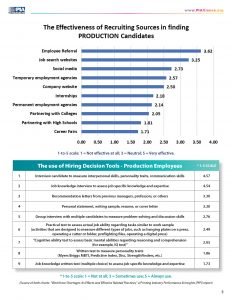
ore qualified candidates. The survey data also suggest that higher-performing firms get their better results by applying just a few more tools for making hiring decisions than lower-performing firms (see chart).
These resources are available to every printer, but they have to be used judiciously. “Companies still need to be very careful and very strategic, because those recruiting dollars are very precious,” Moake advises. “You don’t want to just throw money at anything and everything that everyone else is doing.” Something to bear in mind here is how technology is changing the way recruiting occurs: for example, through applicant tracking software systems that let employers maximize the efficiency of the hiring process.
In all cases, Ralph Williams emphasizes, “you have to strategically decide what you are going to use both in recruiting and hiring to fit the position that you’re seeking to fill. One basket of those tools doesn’t fit every position you have.”
To keep reading, download the Recruitment, Retention and Pathways to Employment in the Printing Industry White Paper.
Contact me at tim@printcommunications.org or (716) 691-3211 with any questions.
Tim Freeman, President
Print & Graphic Communications Association

